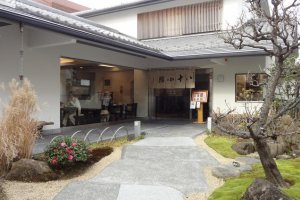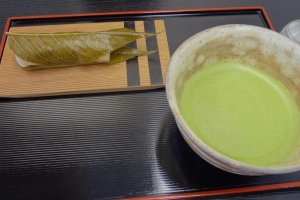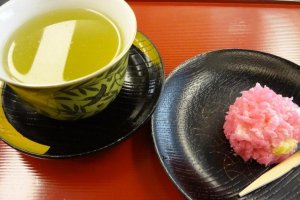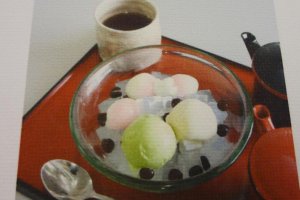I would like to introduce a nice, elegant, traditional Japanese tearoom in Kamakura called Hato-koji.
But first, a bit about Japanese green tea
There are two types of Japanese green tea: Matcha (抹茶) and Sencha (煎茶). Matcha is made from dried powder taken from tea leaves. The way we make it is like this: Put some matcha powder in a cup and pour in hot water. Then stir and whip until it foams up. Serve. This tea is thick, and is close to what you might experience in a traditional tea ceremony, sitting on a tatami mat.
Sencha is made from leaves that are steamed and rubbed in a complicated process, and then served in almost the same way as British tea; Put some tea leaves in a pot, pour hot water and wait. Houjicha (ほうじ茶) is made from roasted Sencha leaves. It tastes less bitter and harsh than Sencha.
Hato-koji Tearoom
Hato-koji is a modern style Japanese tearoom that serves traditional tea and deserts. They have three types of Japanese tea with tasty Japanese sweets in comfortable table seats. Here are my recommendations:
*Matcha and Sakura-mochi (630 yen)
Sakura-mochi is a rice cake with bean jam. The rice cakes are wrapped in cherry tree leaves preserved in salt. Enjoy the delicate, superb balance of sweetness and refined saltiness. After you fill your palate with the fine mochi, sip the matcha please. You will agree that the bitter tea is not bitter anymore, and the combination of these two is perfect.
*Sencha and Jo-nama (500 yen)
Jo-nama is a sweet cake expressing nature in her four seasons. It is usually made of simple ingredients such as sugar, starch syrup, rice, wheat and azuki bean. I love the taste of it, but more than that, I simply adore the appearance of each cake. Enjoy its delicate texture through your five senses! Sencha also has a complex taste. First comes harshness, then slight bitterness, and finally sweetness. The aroma of the tea is fresh and clear. The bright green color is nice on your eyes. When you swallow it, your tongue and throat will catch the comfortable heat. Then finally you can listen to a sound of satisfaction; your sigh of relief.
*Bancha and Ogura-shiratama (630 yen)
Ogura-shiratama is rice dumplings in azuki bean jam. This bean jam is thick and heavy. But…you can’t stop eating it, I’m sure! Bancha tastes quite mild but it has a strong aroma. Ogura-shiratama contains the straight sweetness of bean jam, and so, the bancha can soften the taste with its own flavor.
Access
The entrance of the tearoom is a bit difficult to find. So, first go to the famous, traditional confectionary shop, Toshima-ya honten (also known as the Hato Sablé main shop. Its logo is in the shape of a dove). Then take the small path to the left of the shop. The path leads you straight to the side entrance gate of the Hato-koji tearoom.
Hato-koji is just the right place for taking a break while strolling around Kamakura.



































